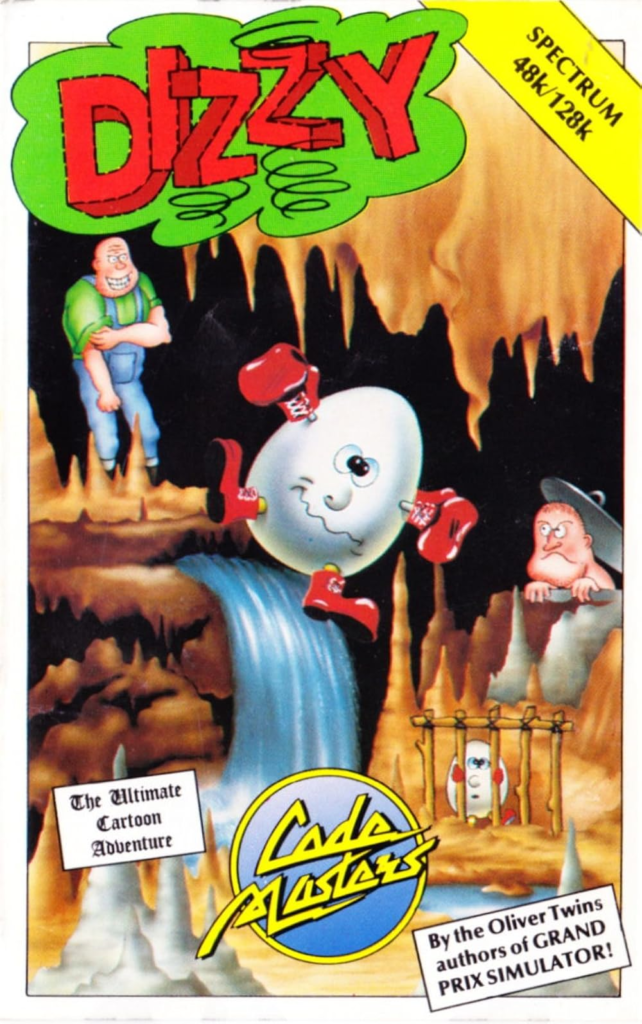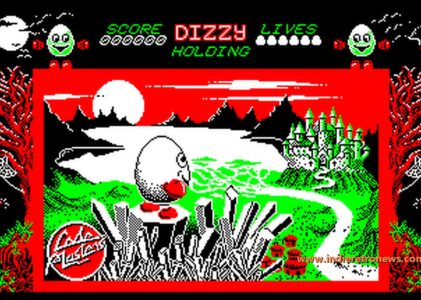Unveiling the adventures of a brave egg named Dizzy
The Dizzy series, a beloved classic in the world of video gaming, made its debut in 1987, taking players on a whimsical journey with a daring egg named Dizzy. This timeless franchise has left an indelible mark on the gaming landscape, spanning several platforms and captivating players with its unique blend of puzzle-solving, platforming, and charming characters. In this deep dive, we’ll explore the genre and platforms of the Dizzy series, its gameplay, key features, strategies, and even some cheats. We’ll also delve into its critical reception, cultural impact, sequels, and provide examples of similar games that have been inspired by Dizzy’s adventures.

Genre and Platforms
The Dizzy series is primarily known for its contributions to the platformer and adventure game genres. Created by the Oliver Twins, Philip and Andrew Oliver, and published by Codemasters, these games found their home on a variety of platforms during their heyday. Some of the notable platforms the Dizzy series graced include:
- ZX Spectrum: The series started its journey on this 8-bit home computer, gaining popularity among gamers in Europe. The simplicity of the ZX Spectrum’s hardware made it an ideal platform for Dizzy’s adventures.
- Amstrad CPC: Another popular 8-bit platform, the Amstrad CPC, saw its fair share of Dizzy titles. The colorful visuals and quirky gameplay resonated with Amstrad users.
- Commodore 64: Dizzy’s egg-ceptional adventures were also available on the Commodore 64, captivating players with its imaginative worlds and brain-teasing puzzles.
- Amiga: As the series evolved, it made its way onto more powerful platforms like the Amiga, where improved graphics and sound enhanced the Dizzy experience.
- NES (Nintendo Entertainment System): Dizzy crossed the ocean and landed on the NES, introducing North American gamers to its charming gameplay. Here, it gained a dedicated following and became a cult classic.
- Sega Master System: Sega fans were not left out, as Dizzy’s adventures were also available on the Sega Master System, broadening its reach across different gaming communities.
- Atari ST: The Atari ST, known for its advanced graphics and sound capabilities, hosted some Dizzy titles, ensuring that players on this platform could also embark on Dizzy’s quests.

Gameplay
The gameplay in the Dizzy series is characterized by a unique blend of platforming and puzzle-solving. Players control Dizzy, an anthropomorphic egg with red boxing gloves, on his quest to rescue his friends, the Yolkfolk, and thwart the nefarious plans of his arch-nemesis, the evil wizard Zaks. The games are set in a whimsical and colorful fantasy world, and players must explore various locations, interact with quirky characters, and collect items to progress.
One of the defining features of Dizzy games is the inventory system. Dizzy can carry only a limited number of items at a time, and players must strategically choose which items to pick up and use to overcome obstacles and solve puzzles. This mechanic adds a layer of complexity and critical thinking to the gameplay, as players must often backtrack to retrieve items left behind.
The series also incorporates platforming elements, with Dizzy jumping and rolling his way through a variety of obstacles and enemies. Precision and timing are crucial, as falling from heights or colliding with hazards can lead to Dizzy’s untimely demise.

Key Gameplay Features
The Dizzy series introduced several key gameplay features that set it apart from other platformers and adventure games of its time:
- Inventory System: As mentioned earlier, Dizzy’s limited inventory space challenges players to make strategic decisions about which items to carry, adding depth to the puzzle-solving aspect of the game.
- Interaction with Characters: Dizzy interacts with a cast of memorable characters, each with their own quirks and personalities. These interactions often hold clues to solving puzzles or progressing in the game.
- Non-Linear Exploration: Many Dizzy games offer non-linear gameplay, allowing players to explore the game world at their own pace and tackle puzzles in different orders.
- Charming Art Style: The series is known for its charming and colorful hand-drawn graphics, which contribute to the game’s whimsical atmosphere.
- Humor and Wit: The Dizzy games are laced with humor and wit, from pun-filled dialogues to cleverly designed puzzles. This sense of humor has endeared the series to players of all ages.
Strategies and Cheats
Mastering the Dizzy series requires a combination of careful exploration, puzzle-solving skills, and platforming finesse. Here are some strategies to help you navigate Dizzy’s egg-citing adventures:
- Take Notes: Since the Dizzy games often involve intricate puzzles and clues from characters, keeping a notebook handy to jot down information can be immensely helpful.
- Experiment with Items: Don’t be afraid to try using different items in various situations. Sometimes, unexpected combinations can lead to solutions.
- Save Often: In games that allow it, use the save feature frequently. This can prevent frustrating setbacks if Dizzy meets an unfortunate end.
- Plan Your Routes: When exploring the game world, plan your routes carefully to minimize backtracking. Remember that Dizzy can only carry a limited number of items, so choose wisely.
- Interact with Characters: Engage in conversations with the game’s characters. They often provide hints and clues that are essential for progressing.
As for cheats, the Dizzy series is known for its challenging gameplay, but some players seek shortcuts. While using cheats can diminish the satisfaction of completing the game, they can be fun for experimentation. However, it’s essential to play through the games without cheats for the full experience. Cheats for Dizzy games typically involve manipulating the game’s code or using level skip codes.
Reviews and Cultural Impact
The Dizzy series garnered positive reviews and left a lasting cultural impact on the gaming community. Critics and players alike appreciated its unique blend of puzzle-solving and platforming, along with its charming characters and humor.
One of the reasons for the series’ success was its accessibility. Dizzy games were known for being family-friendly and suitable for players of all ages. This made them an attractive option for parents looking for games to share with their children.
The Dizzy series also had a notable impact on the adventure game genre, inspiring future titles with similar mechanics and puzzle-solving elements. Its influence can be seen in games like “The Legend of Zelda” series, which also features an inventory system and a hero embarking on quests in a whimsical world.
Additionally, Dizzy’s iconic character design and memorable adventures made him a recognizable figure in the gaming world. The character’s popularity extended beyond games, with Dizzy appearing in various merchandise, including books, comics, and even a cartoon series.
Sequels
The success of the original Dizzy game led to the creation of numerous sequels and spin-off titles. These games expanded on the adventures of Dizzy and the Yolkfolk, offering players new challenges and puzzles to solve. Some notable sequels in the Dizzy series include:
- Treasure Island Dizzy (1988): In this installment, Dizzy embarks on a treasure-hunting adventure on a tropical island, encountering pirates and unraveling the secrets of buried treasure.
- Fantasy World Dizzy (1989): Dizzy’s adventures take a fantastical turn in this game, where he must save the Yolkfolk from a spell cast by the evil wizard Zaks.
- Magicland Dizzy (1990): Dizzy explores the whimsical Magicland to rescue Daisy from the clutches of the evil wizard Zaks once again.
- Spellbound Dizzy (1991): This game introduces a more extensive game world, with Dizzy on a quest to rescue his girlfriend Daisy and uncover the secrets of a powerful spellbook.
- Crystal Kingdom Dizzy (1992): In the final mainline Dizzy game, our hero must rescue the Yolkfolk and thwart Zaks’s plan to take over the Crystal Kingdom.
Examples of Similar Games

While the Dizzy series is unique in its own right, it has inspired several games that incorporate similar gameplay mechanics and a whimsical, puzzle-solving adventure style. Here are a few examples:
- Beneath a Steel Sky (1994): This point-and-click adventure game draws inspiration from the Dizzy series with its humor, puzzle-solving, and memorable characters.
- Simon the Sorcerer (1993): Another classic point-and-click adventure game, Simon the Sorcerer features a quirky protagonist and challenging puzzles reminiscent of Dizzy.
- Pajama Sam series (1996-2001): Aimed at a younger audience, the Pajama Sam series offers humorous, puzzle-filled adventures for children, akin to Dizzy’s family-friendly appeal.
- Psychonauts (2005): This 3D platformer combines humor, platforming, and puzzle-solving in a unique and imaginative world, drawing comparisons to the charm of the Dizzy series.
- A Hat in Time (2017): This modern 3D platformer evokes the spirit of classic platforming games, offering a whimsical world to explore and challenging puzzles to solve.
The Dizzy series
The Dizzy series, with its endearing protagonist and challenging yet accessible gameplay, continues to hold a special place in the hearts of gamers worldwide. Its legacy can be seen in the many games it inspired and the fond memories it created for those who embarked on Dizzy’s egg-citing adventures.
- Dizzy Retro Gaming: A dedicated website that provides information, reviews, and resources related to the Dizzy series and its various games.
- The Oliver Twins Official Website: The official website of the creators of the Dizzy series, Philip and Andrew Oliver. It offers insights into their game development journey, including the Dizzy games.
- World of Spectrum – Dizzy Series: World of Spectrum’s section on the Dizzy series, featuring information, reviews, and downloads of Dizzy games for the ZX Spectrum.
- Lemon Amiga – Dizzy Series: Lemon Amiga’s page dedicated to the Dizzy series, with reviews, screenshots, and discussions about Dizzy games on the Amiga platform.
- Classic Gaming Quarterly – Dizzy Retrospective: A YouTube video retrospective by Classic Gaming Quarterly that provides an in-depth look at the Dizzy series, its gameplay, and its impact on gaming.
Note: This article has provided an extensive overview of the Dizzy series, covering its genre, platforms, gameplay, key features, strategies, cheats, reviews, cultural impact, sequels, and examples of similar games. It showcases how this classic series has left an indelible mark on the gaming world and continues to be remembered fondly by gamers of all ages.













